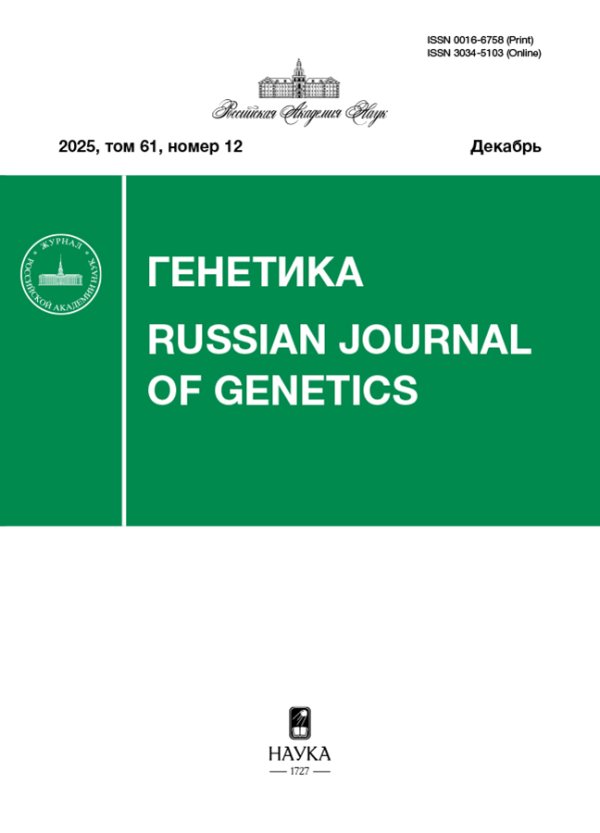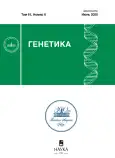Variability of the promoter-operator region of Bacillus cereus hlyII gene impacts on its transcriptional activity level
- Authors: Shadrin A.M.1, Shapyrina E.V.1, Nagel A.S.1, Siunov A.V.1, Andreeva-Kovalevskaya Z.I.1, Salyamov V.I.1, Solonin A.S.1
-
Affiliations:
- Skryabin Institute of Biochemistry and Physiology of Microorganisms, FSBIS FRC Pushchino Scientific Centre of Biological Research, Russian Academy of Sciences
- Issue: Vol 61, No 6 (2025)
- Pages: 99-104
- Section: КРАТКИЕ СООБЩЕНИЯ
- URL: https://bakhtiniada.ru/0016-6758/article/view/305970
- DOI: https://doi.org/10.31857/S0016675825060098
- EDN: https://elibrary.ru/swbrjq
- ID: 305970
Cite item
Abstract
The promoter-operator region of the Bacillus cereus hlyII gene includes an elongated operator region with mirror symmetry, recognizable with the main specific transcriptional regulator HlyIIR. In addition, regions for the global transcription regulators Fur, OhrR, and ResD, are located in the region of the hlyII gene operator. The latter is a transcriptional regulator of the redox-sensitive ResDE signal transduction pathway. Bacillus cereus sensu lato strains were found with a disturbance in the proximal part of the area recognized by HlyIIR and ResD. The essential role of these regions in the expression of the hlyII gene has been demonstrated. Natural strains of Bacillus cereus with deletions in the proximal region of the HlyIIR operator of the hlyII gene have a significantly reduced expression level of hlyII were identified. Disturbances in HlyIIR operator reduce the expression of hlyII several tens of times. The presence of an intact recognition site for ResD reduces the expression of this gene several times under aerobic conditions. These results allow us to determine the influence of structural variability in the promoter-operator region of Bacillus cereus hlyII genes on its transcriptional activity.
About the authors
A. M. Shadrin
Skryabin Institute of Biochemistry and Physiology of Microorganisms, FSBIS FRC Pushchino Scientific Centre of Biological Research, Russian Academy of Sciences
Email: solonin.a.s@yandex.ru
Moscow oblast, Pushchino, 142290 Russia
E. V. Shapyrina
Skryabin Institute of Biochemistry and Physiology of Microorganisms, FSBIS FRC Pushchino Scientific Centre of Biological Research, Russian Academy of Sciences
Email: solonin.a.s@yandex.ru
Moscow oblast, Pushchino, 142290 Russia
A. S. Nagel
Skryabin Institute of Biochemistry and Physiology of Microorganisms, FSBIS FRC Pushchino Scientific Centre of Biological Research, Russian Academy of Sciences
Email: solonin.a.s@yandex.ru
Moscow oblast, Pushchino, 142290 Russia
A. V. Siunov
Skryabin Institute of Biochemistry and Physiology of Microorganisms, FSBIS FRC Pushchino Scientific Centre of Biological Research, Russian Academy of Sciences
Email: solonin.a.s@yandex.ru
Moscow oblast, Pushchino, 142290 Russia
Zh. I. Andreeva-Kovalevskaya
Skryabin Institute of Biochemistry and Physiology of Microorganisms, FSBIS FRC Pushchino Scientific Centre of Biological Research, Russian Academy of Sciences
Email: solonin.a.s@yandex.ru
Moscow oblast, Pushchino, 142290 Russia
V. I. Salyamov
Skryabin Institute of Biochemistry and Physiology of Microorganisms, FSBIS FRC Pushchino Scientific Centre of Biological Research, Russian Academy of Sciences
Email: solonin.a.s@yandex.ru
Moscow oblast, Pushchino, 142290 Russia
A. S. Solonin
Skryabin Institute of Biochemistry and Physiology of Microorganisms, FSBIS FRC Pushchino Scientific Centre of Biological Research, Russian Academy of Sciences
Author for correspondence.
Email: solonin.a.s@yandex.ru
Moscow oblast, Pushchino, 142290 Russia
References
- Bottone E.J. Bacillus cereus, a volatile human pathogen // Clin. Microbiol. Rev. 2010. V. 23. № 2. P. 382–398. https://doi.org/10.1128/CMR.00073-09
- Hall-Stoodley L., Stoodley P. Evolving concepts in biofilm infections // Cell Microbiol. 2009. V. 11. № 7. P. 1034–1043. https://doi.org/10.1111/j.1462-5822.2009.01323.x
- Hsueh Y.-H., Somers E.B., Lereclus D. et al. Biofilm formation by Bacillus cereus is influenced by PlcR, a pleiotropic regulator // Appl. Environ. Microbiol. 2006. V. 72. № 7. P. 5089–5092. https://doi.org/10.1128/AEM.00573-06
- John S., Neary J., Lee C.H. Invasive Bacillus cereus infection in a renal transplant patient: A case report and review // Can. J. Infect. Dis. Med. Microbiol. 2012. V. 23. № 4. P. e109–110. https://doi.org/10.1155/2012/461020
- Ramarao N., Lereclus D. The InhA1 metalloprotease allows spores of the B. cereus group to escape macrophages // Cell Microbiol. 2005. V. 7. № 9. P. 1357–1364. https://doi.org/10.1111/j.1462-5822.2005.00562.x
- Baida G., Budarina Z.I., Kuzmin N.P. et al. Complete nucleotide sequence and molecular characterization of hemolysin II gene from Bacillus cereus // FEMS Microbiol. Lett. 1999. V. 180. № 1. P. 7–14. https://doi.org/10.1111/j.1574-6968.1999.tb08771.x
- Sineva E.V., Andreeva-Kovalevskaya Z.I., Shadrin A.M. et al. Expression of Bacillus cereus hemolysin II in Bacillus subtilis renders the bacteria pathogenic for the crustacean Daphnia magna // FEMS Microbiol. Lett. 2009. V. 299. № 1. P. 110–119. https://doi.org/10.1111/j.1574-6968.2009.01742.x
- Kataev A.A., Andreeva-Kovalevskaya Z.I., Solonin A.S. et al. Bacillus cereus can attack the cell membranes of the alga Chara corallina by means of HlyII // Biochim. Biophys. Acta. 2012. V. 1818. № 5. P. 1235–1241. https://doi.org/10.1016/j.bbamem.2012.01.010
- Cadot C., Tran S.-L., Vignaud M.-L. et al. InhA1, NprA, and HlyII as candidates for markers to differentiate pathogenic from nonpathogenic Bacillus cereus strains // J. Clin. Microbiol. 2010. V. 48. № 4. P. 1358–1365. https://doi.org/10.1128/JCM.02123-09
- Rodikova E.A., Kovalevskiy O.V., Mayorov S.G. et al. Two HlyIIR dimers bind to a long perfect inverted repeat in the operator of the hemolysin II gene from Bacillus cereus // FEBS Lett. 2007. V. 581. № 6. P. 1190–1196. https://doi.org/10.1016/j.febslet.2007.02.035
- Budarina Z.I., Nikitin D.V., Zenkin N. et al. A new Bacillus cereus DNA-binding protein, HlyIIR, negatively regulates expression of B. cereus haemolysin II // Microbiology. (Reading). 2004. V. 150. № Pt 11. P. 3691–3701. https://doi.org/10.1099/mic.0.27142-0
- Kovalevskiy O.V., Lebedev A.A., Surin A.K. et al. Crystal structure of Bacillus cereus HlyIIR, a transcriptional regulator of the gene for pore-forming toxin hemolysin II // J. Mol. Biol. 2007. V. 365. № 3. P. 825–834. https://doi.org/10.1016/j.jmb.2006.10.074
- Ramarao N., Sanchis V. The pore-forming haemolysins of bacillus cereus: A review // Toxins (Basel). 2013. V. 5. № 6. P. 1119–1139. https://doi.org/10.3390/toxins5061119
- Gupta L.K., Molla J., Prabhu A.A. Story of pore-forming proteins from deadly disease-causing agents to modern applications with evolutionary significance // Mol. Biotechnol. 2024. V. 66. № 6. P. 1327–1356. https://doi.org/10.1007/s12033-023-00776-1
- Lopez Chiloeches M., Bergonzini A., Frisan T. Bacterial toxins are a never-ending source of surprises: From natural born killers to negotiators // Toxins (Basel). 2021. V. 13. № 6. https://doi.org/10.3390/toxins13060426
- Helgason E., Caugant D.A., Olsen I. et al. Genetic structure of population of Bacillus cereus and B. thuringiensis isolates associated with periodontitis and other human infections // J. Clin. Microbiol. 2000. V. 38. № 4. P. 1615–1622. https://doi.org/10.1128/JCM.38.4.1615-1622.2000
- Baichoo N., Helmann J.D. Recognition of DNA by Fur: A reinterpretation of the Fur box consensus sequence // J. Bacteriol. 2002. V. 184. № 21. P. 5826–5832. https://doi.org/10.1128/JB.184.21.5826-5832.2002
- Sineva E., Shadrin A., Rodikova E.A. et al. Iron regulates expression of Bacillus cereus hemolysin II via global regulator Fur // J. Bacteriol. 2012. V. 194. № 13. P. 3327–3335. https://doi.org/10.1128/JB.00199-12
- Rosenfeld E., Duport C., Zigha A. et al. Characterization of aerobic and anaerobic vegetative growth of the food-borne pathogen Bacillus cereus F4430/73 strain // Can. J. Microbiol. 2005. V. 51. № 2. P. 149–158. https://doi.org/10.1139/w04-132
- Jacob H., Geng H., Shetty D. et al. Distinct interaction mechanism of RNA polymerase and ResD at proximal and distal subsites for transcription activation of nitrite reductase in Bacillus subtilis // J. Bacteriol. 2022. V. 204. № 2. https://doi.org/10.1128/JB.00432-21
- Härtig E., Geng H., Hartmann A. et al. Bacillus subtilis ResD induces expression of the potential regulatory genes yclJK upon oxygen limitation // J. Bacteriol. 2004. V. 186. № 19. P. 6477–6484. https://doi.org/10.1128/JB.186.19.6477-6484.2004
- Esbelin J., Jouanneau Y., Duport C. Bacillus cereus Fnr binds a [4Fe-4S] cluster and forms a ternary complex with ResD and PlcR // BMC Microbiology. 2012. V. 12. № 1. https://doi.org/10.1186/1471-2180-12-125
- Sun G., Sharkova E., Chesnut R. et al. Regulators of aerobic and anaerobic respiration in Bacillus subtilis // J. Bacteriol. 1996. V. 178. № 5. P. 1374–1385. https://doi.org/10.1128/jb.178.5.1374-1385.1996
- Nakano M.M., Zhu Y., Lacelle M. et al. Interaction of ResD with regulatory regions of anaerobically induced genes in Bacillus subtilis // Mol. Microbiol. 2000. V. 37. № 5. P. 1198–1207. https://doi.org/10.1046/j.1365-2958.2000.02075.x
- Sievers F., Wilm A., Dineen D. et al. Fast, scalable generation of high-quality protein multiple sequence alignments using Clustal Omega // Mol. Syst. Biol. 2011. V. 7. P. 539. https://doi.org/10.1038/msb.2011.75
- Geng H., Zhu Y., Mullen K. et al. Characterization of ResDE-dependent fnr transcription in Bacillus subtilis // J. Bacteriol. 2007. V. 189. № 5. P. 1745–1755. https://doi.org/10.1128/JB.01502-06
- Mishra A., Hughes A.C., Amon J.D. et al. SwrA extends DegU over an UP element to activate flagellar gene expression in Bacillus subtilis // bioRxiv. 2023. https://doi.org/10.1101/2023.08.04.552067
Supplementary files










